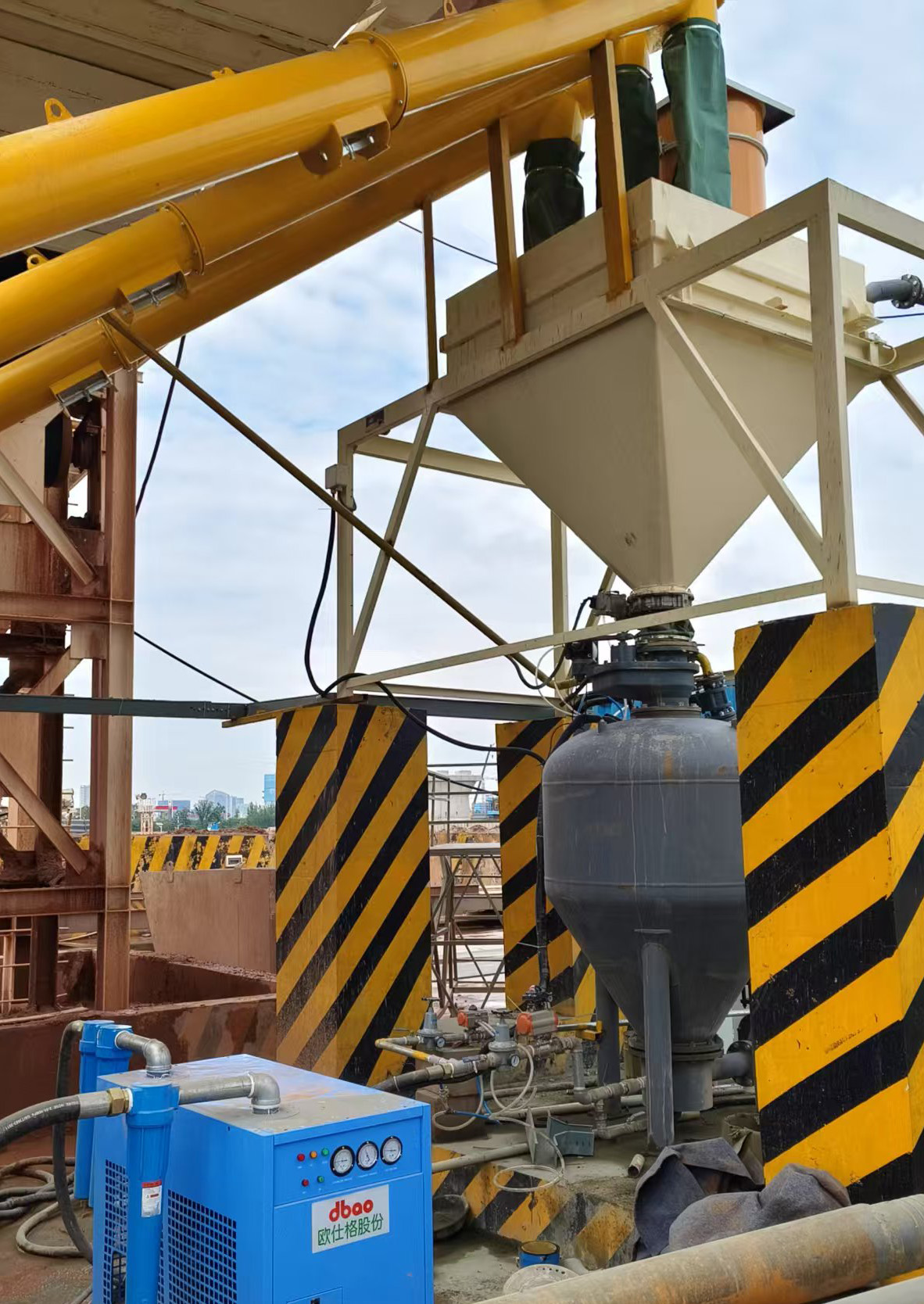在氣力輸送系統中,旋轉供料器是維持系統穩定運行的關鍵部件,其不僅承擔著物料輸送的重任,更直接影響著整個系統的效率與安全性。由于需長期與各類物料接觸并承受摩擦,它也成為系統中需要重點關注的易損部件。以下從多個維度深入解析旋轉供料器的特性與設計邏輯。
In pneumatic conveying systems, the rotary feeder is a key component that maintains stable operation of the system. It not only bears the responsibility of material conveying, but also directly affects the efficiency and safety of the entire system. Due to the long-term contact and friction with various materials, it has also become a vulnerable component that requires special attention in the system. The following provides a comprehensive analysis of the characteristics and design logic of rotary feeders from multiple dimensions.
核心功能與工作機理方面,旋轉供料器作為系統中的 “物料閘門”,通過帶葉片的轉子在機殼內的精準轉動實現雙重功能:一方面,將上部料倉的物料通過葉片間隙均勻帶入下部輸送通道,完成定量給料;另一方面,利用轉子與機殼間的緊密配合阻斷上下氣流流通,起到鎖氣作用,避免輸送氣流反向竄入料倉影響物料下落。這種 “輸送 + 鎖氣” 的一體化設計,使其成為連接料倉與輸送管道的核心樞紐,確保物料在氣壓環境下有序流動。
In terms of core functions and working mechanisms, the rotary feeder serves as the "material gate" in the system, achieving dual functions through the precise rotation of the rotor with blades inside the casing: on the one hand, it evenly transports the material from the upper silo into the lower conveying channel through the blade gap, completing quantitative feeding; On the other hand, the tight fit between the rotor and the casing is used to block the flow of upper and lower air, which plays a role in locking the air and avoiding the reverse flow of conveying air into the material bin, which may affect the falling of materials. This integrated design of "conveying+air locking" makes it the core hub connecting the silo and conveying pipeline, ensuring orderly flow of materials under atmospheric pressure.
材質選擇的科學依據直接關系到設備壽命。常見的材質類型需根據物料特性針對性選用:不銹鋼材質憑借優異的耐腐蝕性,適用于輸送化工原料、食品級粉末等具有腐蝕性或衛生要求高的物料;普通碳鋼材質成本適中、強度足夠,適合輸送煤塊、礦石等無腐蝕性的塊狀物料;耐磨陶瓷材質則通過在關鍵摩擦面鑲嵌陶瓷片,大幅提升抗磨損能力,多用于輸送石英砂、金剛砂等硬度高、易磨損設備的物料。材質的耐磨性、耐腐蝕性與物料特性的匹配度,是決定設備使用壽命的關鍵因素。
The scientific basis for material selection is directly related to the lifespan of the equipment. Common material types need to be selected according to their specific characteristics: stainless steel material, with its excellent corrosion resistance, is suitable for transporting corrosive or high hygiene materials such as chemical raw materials and food grade powders; Ordinary carbon steel material has moderate cost and sufficient strength, suitable for transporting non corrosive block materials such as coal and ore; Wear resistant ceramic materials greatly enhance their wear resistance by embedding ceramic plates on key friction surfaces, and are commonly used for conveying materials with high hardness and easy wear such as quartz sand and diamond sand. The matching degree between the wear resistance, corrosion resistance, and material characteristics of materials is a key factor determining the service life of equipment.

結構設計的合理性對防卡塞至關重要。轉子構造的差異使其適應不同物料:P 型轉子葉片呈平直狀,適合輸送流動性好、不易結塊的顆粒狀物料,如谷物、塑料顆粒等;V 型轉子葉片采用傾斜角度設計,在轉動時能對物料產生一定的疏導作用,更適用于纖維狀、略帶粘性的物料,可減少因物料纏繞導致的卡塞風險。合理的結構設計能降低物料在輸送過程中的滯留概率,確保設備連續穩定運行。
The rationality of structural design is crucial for preventing jamming. The differences in rotor structure make it suitable for different materials: P-type rotor blades are flat, suitable for conveying granular materials with good fluidity and low clumping, such as grains, plastic particles, etc; The V-shaped rotor blades are designed with an inclined angle, which can provide a certain guiding effect on the material during rotation. They are more suitable for fibrous and slightly viscous materials, and can reduce the risk of jamming caused by material entanglement. Reasonable structural design can reduce the probability of material retention during transportation and ensure the continuous and stable operation of equipment.
輔助部件的協同作用進一步提升設備效能。旋轉供料器上部配置的抽氣室,通過適時排出局部積氣,避免因物料中夾雜的空氣在葉片間隙形成氣阻,從而預防物料卡滯;下部的加速室則接入羅茨風機或其他氣源設備提供的高壓氣流,當物料從葉片間隙落下時,高速氣流能迅速將其裹挾并送入輸送管道,增強物料的初始動能,減少在管道入口處的堆積。這些輔助結構與主閥體形成有機整體,共同保障物料輸送的順暢性。
The collaborative effect of auxiliary components further enhances equipment efficiency. The upper part of the rotary feeder is equipped with an exhaust chamber, which timely discharges local air accumulation to avoid the formation of air resistance in the blade gap due to air inclusions in the material, thereby preventing material jamming; The lower acceleration chamber is connected to a high-pressure airflow provided by a Roots blower or other air source equipment. When the material falls from the blade gap, the high-speed airflow can quickly wrap it and send it into the conveying pipeline, enhancing the initial kinetic energy of the material and reducing the accumulation at the inlet of the pipeline. These auxiliary structures form an organic whole with the main valve body, jointly ensuring the smoothness of material transportation.
旋轉供料器的設計細節充分體現了 “因料制宜” 的原則,從材質選擇到結構優化,再到輔助部件的配置,每一處設計都圍繞物料特性與系統需求展開。深入理解這些特性,有助于在氣力輸送系統設計與設備選型時做出更合理的決策,充分發揮其在系統中的核心作用。
The design details of the rotary feeder fully reflect the principle of "tailored to the material", from material selection to structural optimization, to the configuration of auxiliary components, every design is centered around material characteristics and system requirements. A deep understanding of these characteristics can help make more rational decisions in the design and equipment selection of pneumatic conveying systems, fully leveraging their core role in the system.
本文由旋轉供料器友情奉獻.更多有關的知識請點擊:http://m.nrzyhzp.cn/我們將會對您提出的疑問進行詳細的解答,歡迎您登錄網站留言.
This article is dedicated to friendship For more information, please click: We will provide detailed answers to your questions. You are welcome to log in to our website and leave a message
聯系電話
二維碼
